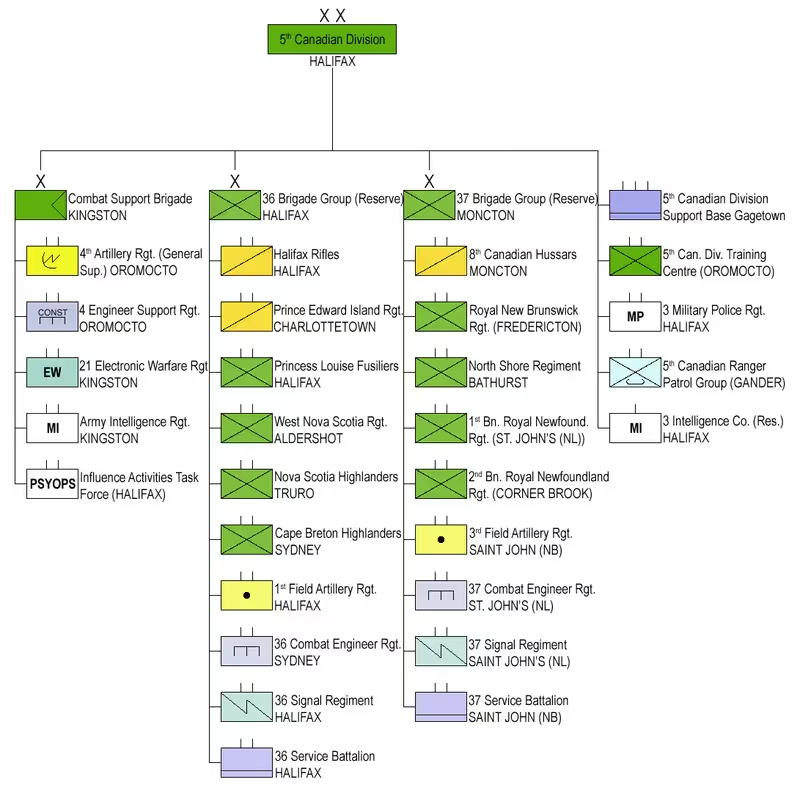Canadian Army Order of Battle (ORBAT), 2024
.avif)
(Joanne Clifford Photo)
The Canadian Army, 2023
The 1st Canadian Division (French: 1re Division du Canada ) is a joint operational command and control formation based at CFB Kingston, and falls under Canadian Joint Operations Command. It is a high-readiness unit, able to move on very short notice, and is staffed and equipped to meet Canada’s military objectives to counter any potential threat.
Formed during the First World War in August 1914, the 1st Canadian Division was a formation of the Canadian Expeditionary Force. The division contained a cavalry squadron and a cyclist company, three infantry brigades (the 1st, 2nd and 3rd Canadian Infantry Brigades, each of four battalions), representing all parts of Canada, three field artillery brigades (roughly equivalent to modern regiments) armed with 18-pounders and engineers, together with elements of the Army Service Corps and the Army Medical Corps. The total war establishment of the Division was 17,873 all ranks, with 4,943 horses.[1] During its service in the First World War, the Division fought at Ypres, Festubert, the Somme, Vimy Ridge, Passchendaele and Amiens among other notable battles on the Western Front.
Following the war, the division was stood down, only to be re-mobilized as a formation on 1 September 1939 as the 1st Canadian Infantry Division for service in the Second World War. The Division was part of the Allied campaign to invade Sicily, as well as their campaign on the Italian mainland, where they are associated with such notable battles as Ortona, the Liri Valley and the Gothic Line. The Division reunited with the First Canadian Army in 1945 to participate in the liberation of the Western Netherlands before the end of the war in Europe.
The division was also reactivated twice during the Cold War: from 1953 to 1958, and again from 1988 to 1992.
In 2010, the division was reactivated for a third time. While the four divisions (2nd to 5th) of the Canadian Army are responsible for command of units within their respective geographic regions, the 1st Canadian Division Headquarters was formed to serve as a task-tailored, deployable joint headquarters at high readiness to command and control joint, inter-agency, multinational forces to achieve national objectives at home and abroad.
On 19 May 2010, Chief of the Defence Staff, General Walter Natynczyk, announced that the Canadian Forces would once again stand up the 1st Canadian Division at Kingston, Ontario. The role of 1st Canadian Division upon reactivation was to provide the Canadian Forces with a rapidly deployable joint command and control capacity in order to allow for a comprehensive approach to operations. As planning for the revitalised Division progressed, the HQ was tasked at very short notice to deploy to Malta as a Joint Task Force Headquarters on Operation MOBILE to coordinate the evacuation of Canadians and other civilians from Libya – an extremely successful mission where personnel from both Canada and other nations were evacuated.
1st Cdn Div HQ officially was stood up on 7 October 2010 at Kingston, with Defence Minister Peter MacKay acting as the reviewing officer. Headquarters 1st Canadian Division is part of the Canadian Army administratively and remains at Canadian Forces Base Kingston using existing infrastructure and base support. Major-General David Fraser, former Commandant of the Canadian Forces College in Toronto and the first Canadian commander of the Multi-National Brigade (Regional Command (South)) in Afghanistan, was designated as the first commander of the newly reactivated 1st Canadian Division.
On 1 April 2015, 1st Canadian Division was transferred from the Canadian Army to Canadian Joint Operations Command.
· 2nd Canadian Division
o 2nd Canadian Division Headquarters
o 4 Intelligence Company
o 2 Canadian Ranger Patrol Group
o 5 Area Construction Troop, 4 Engineer Support Regiment
o 2nd Canadian Division Training Centre
o 5 Canadian Mechanized Brigade Group
o 34 Canadian Brigade Group
o 35 Canadian Brigade Group
o 2nd Canadian Division Support Group

· 3rd Canadian Division
o 3rd Canadian Division Headquarters
o 6 Intelligence Company
o 1 Canadian Ranger Patrol Group
o 4 Canadian Ranger Patrol Group
o 1 Area Construction Troop, 4 Engineer Support Regiment
o 1 Military Police Regiment
o 3rd Canadian Division Training Centre
o 1 Canadian Mechanized Brigade Group
o 38 Canadian Brigade Group
o 39 Canadian Brigade Group
o 41 Canadian Brigade Group
o 3rd Canadian Division Support Group

· 4th Canadian Division
o 4th Canadian Division Headquarters
o 2 Intelligence Company
o 3 Canadian Ranger Patrol Group
o 2 Military Police Regiment
o 4th Canadian Division Training Centre
o 2 Canadian Mechanized Brigade Group
o 31 Canadian Brigade Group
o 32 Canadian Brigade Group
o 33 Canadian Brigade Group
o 4th Canadian Division Support Group

· 5th Canadian Division
o 5th Canadian Division Headquarters
o 3 Intelligence Company
o 5 Canadian Ranger Patrol Group
o 3 Military Police Regiment
o 4 Area Construction Troop, 4 Engineer Support Regiment
o 5th Canadian Division Training Centre
o 36 Canadian Brigade Group
o 37 Canadian Brigade Group
o 5th Canadian Division Support Group
o Canadian Combat Support Brigade
§ Influence Activities Task Force (PsyOps, CIMIC)
§ Canadian Army Intelligence Regiment
§ 21 Electronic Warfare Regiment
§ 4th Artillery Regiment, RCA
§ 4 Engineer Support Regiment

Additionally, the command comprises the Canadian Army Doctrine and Training Centre, which includes the following establishments:
· CADTC Headquarters, CFB Kingston
· Command and Staff College, CFB Kingston
· Army Training Directorate
· CIMIC Directorate
· Army Doctrine Directorate, CFB Kingston
· Psyops Directorate
· Combat Training Centre
· Environment Directorate
· School of Communications and Electronics
· Digitization Office
· Lessons Learned Centre
· Peace Support Training Centre, CFB Kingston
· Canadian Manoeuvre Training Centre, CFB Wainwright



